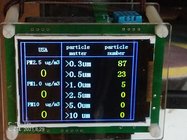... even turning wet wood, there's still dust , except you can't SEE it, and it is what you CANT see that kills you.... I'd suggest to anyone that thinks their turning does not produce any dust, so they don't need a dust mask, respirator, or etc. , to get themselves one of those particulate counters for air quality monitoring...
Here, here, Brian!
It should be next big business opportunity in woodturning as you can't find a particulate counter on offer from any of the major woodturning suppliers. So, no surprise then that most woodturners are not aware how important this small and relatively inexpensive piece of equipment is. The major suppliers offer endless alternatives for dust collection equipment and respiratory protection gear, but not a single device to read how effective any of those are.... I guess if they did we would be quoting PM2.5μ numbers on this forum to share from our experiences just how effective, or otherwise, any of that dust mitigation equipment is in our workshops...
I've had a particulate counter for a number of years now and consider it to be one of the most valuable pieces of equipment in my workshop. I switch it on when I arrive in the workshop and keep an eye on it whatever I'm doing. If I happen to be sanding I closely monitor the readings that tell me if my bell mouth hood is in the optimum position. I don't like to see anything above a reading of 10 in the PM 2.5μ/m3 range, but more often than not I have a PM2.5μm reading like this... I have a highly efficient DE system...
The fine dust particles in the PM2.5μm range are the bad ones. Some of those numbers look high, but the finest particles in the 0.3 to 0.5μm range remain in suspension and get exhaled again, so are of less concern.
Compared to everything else we turners need in our workshops, the counters are not that expensive and price alone isn't a reliable indicator of accuracy ...
Best PM2.5 Air Quality Monitors in 2023 – Smart Air
Whichever unit you buy, remember to take a background reading outside before taking any readings inside to understand the relative fine dust readings inside your workshop.
Last edited:

